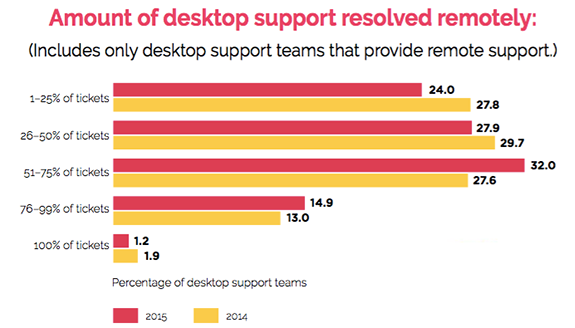Date Published August 18, 2016 - Last Updated December 15, 2016
Remote control technologies for support have changed the way desktop support is done in most organizations. According to the HDI 2015 Support Center Practices & Salary Report, 55 percent of organizations consider remote control a must-have to provide successful support. In the HDI 2015 Desktop Support Practices & Salary Report, remote control ranks second only to an incident management (ITSM or ticketing) system as a must-have.
Because these technologies—whether they are in the form of a network appliance, server-client, or web-based application—have reduced the necessity of deskside visits, support center analysts have been doing more and more of the work formerly done by desktop support technicians. Between 2014 and 2015, there was a decrease in the percentage of organizations where desktop support technicians provide remote support and an increase in the percentage where support center staff are responsible.
While about 15 percent of organizations said they were able to resolve remotely 76 to 99 percent of tickets that were assigned to or classified as desktop support, the highest percentage of organizations (32 percent) said they resolved between half and three-quarters of their desktop tickets remotely.

Source: HDI 2015 Desktop Support Practices & Salary Report
In the one-quarter to on-half who could not resolve the issue remotely, however, someone needed to go to the deskside. In a small office, this isn’t much of an issue. When we start thinking of large office buildings, and university or office campuses, it becomes clear that desktop support technicians ae going to be spending time getting to and from the end users. Many healthcare organizations have satellite clinics to deliver local care, and they may be miles away from IT offices. When we think about businesses that have workers out in the field, such as energy and utility companies, there can be many miles and several hours between a desktop support tech and a customer.
There can be many miles and several hours between a desktop support tech and a customer.

While many ITSM or ticketing tools do track time in the sense that they display elapsed time since the ticket was opened, they are not intended to track analyst or technician travel time—often called windshield time in desktop support. They might automatically track the effort (i.e., the time the analyst spends with the ticket open and working) or they may allow the analyst or technician to manually start and stop a timer. But neither of these options cleanly solves the problem.
There are many tools available to track time spent on projects, hours spent on particular tasks, etc., but do they integrate with ITSM tools? In most cases, they do not, because the tools are not developed and configured with desktop support in mind. Consider the following scenario:
Cheryl is a desktop support technician with ABC Company, which has field offices over a three-state area. Cheryl is the organization’s top expert on a particular type of handheld scanner used in the field offices to track parts and feed the information to a central database. An issue arises affecting many—but not all—of the scanners’ ability to communicate with the database. On Wednesday, Cheryl plans to drive to the farthest office from her home base and the company’s headquarters, fix the affected scanners there, and then begin working her way back to HQ, stopping at each of the offices where the issue exists. Cheryl will be piling up windshield time on this trip. She can:
- Manually start and stop a time-tracking application, then type or paste the results into the company’s ITSM tool
- Complete all the work and then use the times stated in Google maps to enter travel time into the ticket
- Use a mobile app that tracks location and time, then manually enter the result into the ticket
Because these methods depend on manual entry of information into the ITSM tool, the time is often simply not captured and remains unaccounted for—even though everyone knows that the work happened and the destinations were reached.
In 2015, the average salary of a desktop support technician in the US was $53,655, or about $26 per hour. Don’t we want to know where they are spending their time?
Desktop support’s voice should be heard when an organization goes looking for a service management or ticketing tool. While time and travel tracking could be seen as a feature to support center staff, it would definitely be a benefit for desktop support managers.
 Roy Atkinson is HDI's senior writer/analyst, acting as in-house subject matter expert and chief writer for SupportWorld articles and white papers. In addition to being a member of the HDI International Certification Standards Committee and the HDI Desktop Support Advisory Board, Roy is a popular speaker at HDI conferences and is well known to HDI local chapter audiences. His background is in both service desk and desktop support as well as small-business consulting. Roy is highly rated on social media, especially on the topics of IT service management and customer service. He is a cohost of the very popular #custserv (customer service) chat on Twitter, which celebrated its fifth anniversary on December 9, 2014. He holds a master’s certificate in advanced management strategy from Tulane University’s Freeman School of Business, and he is a certified HDI Support Center Manager. Follow him on Twitter @HDI_Analyst and @RoyAtkinson.
Roy Atkinson is HDI's senior writer/analyst, acting as in-house subject matter expert and chief writer for SupportWorld articles and white papers. In addition to being a member of the HDI International Certification Standards Committee and the HDI Desktop Support Advisory Board, Roy is a popular speaker at HDI conferences and is well known to HDI local chapter audiences. His background is in both service desk and desktop support as well as small-business consulting. Roy is highly rated on social media, especially on the topics of IT service management and customer service. He is a cohost of the very popular #custserv (customer service) chat on Twitter, which celebrated its fifth anniversary on December 9, 2014. He holds a master’s certificate in advanced management strategy from Tulane University’s Freeman School of Business, and he is a certified HDI Support Center Manager. Follow him on Twitter @HDI_Analyst and @RoyAtkinson.